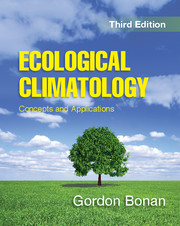Book contents
- Frontmatter
- Dedication
- Contents
- Preface
- 1 Ecosystems and Climate
- Part I The Earth System
- Part II Global Physical Climatology
- Part III Hydrometeorology
- 9 Soil Physics
- 10 Water Balance
- 11 Watershed Hydrology
- 12 Surface Energy Fluxes
- 13 Turbulent Fluxes
- 14 Soil Moisture and the Atmospheric Boundary Layer
- Part IV Biometeorology
- Part V Terrestrial Plant Ecology
- Part VI Terrestrial Forcings and Feedbacks
- Appendix
- Index
- Plate section
- References
9 - Soil Physics
from Part III - Hydrometeorology
Published online by Cambridge University Press: 05 November 2015
- Frontmatter
- Dedication
- Contents
- Preface
- 1 Ecosystems and Climate
- Part I The Earth System
- Part II Global Physical Climatology
- Part III Hydrometeorology
- 9 Soil Physics
- 10 Water Balance
- 11 Watershed Hydrology
- 12 Surface Energy Fluxes
- 13 Turbulent Fluxes
- 14 Soil Moisture and the Atmospheric Boundary Layer
- Part IV Biometeorology
- Part V Terrestrial Plant Ecology
- Part VI Terrestrial Forcings and Feedbacks
- Appendix
- Index
- Plate section
- References
Summary
Chapter Summary
Soils store a considerable amount of heat and water. The diurnal cycle of soil temperature and seasonal variation in soil temperature over the course of a year are important determinants of the land surface climate. The amount of water held in soil regulates evapotranspiration. This chapter reviews the physics of soil heat transfer and soil water relations. Heat flows from high to low temperature through conduction. Important soil properties that determine heat transfer are thermal conductivity and heat capacity. Two forces govern water movement in soil. Gravitational potential represents water movement due to the force of gravity. The second force, called matric potential, occurs because water is bound to soil particles. Water flows from high to low potential as described by Darcy's law. The Richards equation combines Darcy's law with principles of water conservation to describe the change in soil water content over time. Key hydraulic properties are porosity, matric potential, and hydraulic conductivity. These latter two properties vary with soil water. Soils differ in hydraulic properties in relation to the size and arrangement of pores. The pores in sandy soil are large, water loosely adheres to soil particles, water movement is rapid, and the soil drains rapidly. Pores are smaller in clay soil, water is tightly bound to soil particles, movement is slow, and drainage is impeded. Loams are intermediate, draining more slowly than sands and retaining more water.
Soil Texture and Structure
Soils are composed of organic material, mineral particles, air, and water. A typical mineral soil is 55 percent solid particles and 45 percent air and water. Most soils have relatively low organic matter content, ranging from 1 percent to 10 percent. These soils are known as mineral soils. In contrast, organic soils are those in which more than 80 percent of the material is organic matter. These soils develop in swamps, bogs, and marshes where waterlogged conditions inhibit decomposition. The type, abundance, and arrangement of mineral and organic particles determine heat and water flow.
Mineral particles consist of three types determined by size. Sand particles are the largest, ranging in size from 0.05 mm (very fine sand) to 2 mm (very coarse sand). They are rounded or irregular, which creates large pore spaces between particles. Sand particles have a low capacity to hold water. Clay particles are the smallest mineral particles and are less than 0.002 mm in size.
- Type
- Chapter
- Information
- Ecological ClimatologyConcepts and Applications, pp. 143 - 154Publisher: Cambridge University PressPrint publication year: 2015



